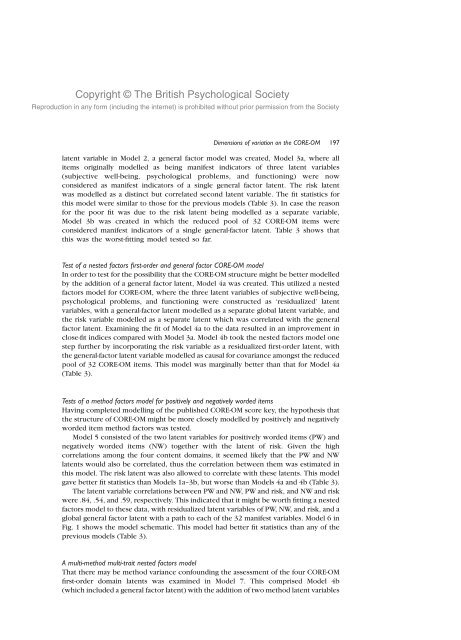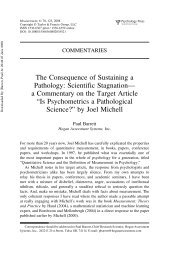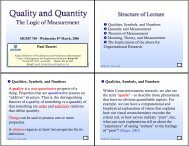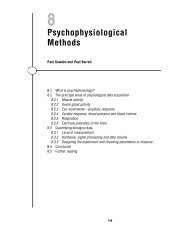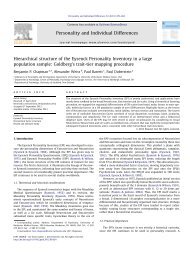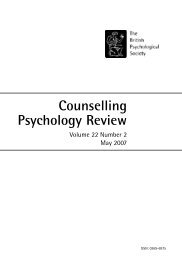Dimensions of variation on the CORE-OM - Paul Barrett
Dimensions of variation on the CORE-OM - Paul Barrett
Dimensions of variation on the CORE-OM - Paul Barrett
Create successful ePaper yourself
Turn your PDF publications into a flip-book with our unique Google optimized e-Paper software.
Copyright © The British Psychological SocietyReproducti<strong>on</strong> in any form (including <strong>the</strong> internet) is prohibited without prior permissi<strong>on</strong> from <strong>the</strong> Society<str<strong>on</strong>g>Dimensi<strong>on</strong>s</str<strong>on</strong>g> <str<strong>on</strong>g>of</str<strong>on</strong>g> <str<strong>on</strong>g>variati<strong>on</strong></str<strong>on</strong>g> <strong>on</strong> <strong>the</strong> <strong>CORE</strong>-<strong>OM</strong> 197latent variable in Model 2, a general factor model was created, Model 3a, where allitems originally modelled as being manifest indicators <str<strong>on</strong>g>of</str<strong>on</strong>g> three latent variables(subjective well-being, psychological problems, and functi<strong>on</strong>ing) were nowc<strong>on</strong>sidered as manifest indicators <str<strong>on</strong>g>of</str<strong>on</strong>g> a single general factor latent. The risk latentwas modelled as a distinct but correlated sec<strong>on</strong>d latent variable. The fit statistics forthis model were similar to those for <strong>the</strong> previous models (Table 3). In case <strong>the</strong> reas<strong>on</strong>for <strong>the</strong> poor fit was due to <strong>the</strong> risk latent being modelled as a separate variable,Model 3b was created in which <strong>the</strong> reduced pool <str<strong>on</strong>g>of</str<strong>on</strong>g> 32 <strong>CORE</strong>-<strong>OM</strong> items werec<strong>on</strong>sidered manifest indicators <str<strong>on</strong>g>of</str<strong>on</strong>g> a single general-factor latent. Table 3 shows thatthis was <strong>the</strong> worst-fitting model tested so far.Test <str<strong>on</strong>g>of</str<strong>on</strong>g> a nested factors first-order and general factor <strong>CORE</strong>-<strong>OM</strong> modelIn order to test for <strong>the</strong> possibility that <strong>the</strong> <strong>CORE</strong>-<strong>OM</strong> structure might be better modelledby <strong>the</strong> additi<strong>on</strong> <str<strong>on</strong>g>of</str<strong>on</strong>g> a general factor latent, Model 4a was created. This utilized a nestedfactors model for <strong>CORE</strong>-<strong>OM</strong>, where <strong>the</strong> three latent variables <str<strong>on</strong>g>of</str<strong>on</strong>g> subjective well-being,psychological problems, and functi<strong>on</strong>ing were c<strong>on</strong>structed as ‘residualized’ latentvariables, with a general-factor latent modelled as a separate global latent variable, and<strong>the</strong> risk variable modelled as a separate latent which was correlated with <strong>the</strong> generalfactor latent. Examining <strong>the</strong> fit <str<strong>on</strong>g>of</str<strong>on</strong>g> Model 4a to <strong>the</strong> data resulted in an improvement inclose-fit indices compared with Model 3a. Model 4b took <strong>the</strong> nested factors model <strong>on</strong>estep fur<strong>the</strong>r by incorporating <strong>the</strong> risk variable as a residualized first-order latent, with<strong>the</strong> general-factor latent variable modelled as causal for covariance am<strong>on</strong>gst <strong>the</strong> reducedpool <str<strong>on</strong>g>of</str<strong>on</strong>g> 32 <strong>CORE</strong>-<strong>OM</strong> items. This model was marginally better than that for Model 4a(Table 3).Tests <str<strong>on</strong>g>of</str<strong>on</strong>g> a method factors model for positively and negatively worded itemsHaving completed modelling <str<strong>on</strong>g>of</str<strong>on</strong>g> <strong>the</strong> published <strong>CORE</strong>-<strong>OM</strong> score key, <strong>the</strong> hypo<strong>the</strong>sis that<strong>the</strong> structure <str<strong>on</strong>g>of</str<strong>on</strong>g> <strong>CORE</strong>-<strong>OM</strong> might be more closely modelled by positively and negativelyworded item method factors was tested.Model 5 c<strong>on</strong>sisted <str<strong>on</strong>g>of</str<strong>on</strong>g> <strong>the</strong> two latent variables for positively worded items (PW) andnegatively worded items (NW) toge<strong>the</strong>r with <strong>the</strong> latent <str<strong>on</strong>g>of</str<strong>on</strong>g> risk. Given <strong>the</strong> highcorrelati<strong>on</strong>s am<strong>on</strong>g <strong>the</strong> four c<strong>on</strong>tent domains, it seemed likely that <strong>the</strong> PW and NWlatents would also be correlated, thus <strong>the</strong> correlati<strong>on</strong> between <strong>the</strong>m was estimated inthis model. The risk latent was also allowed to correlate with <strong>the</strong>se latents. This modelgave better fit statistics than Models 1a–3b, but worse than Models 4a and 4b (Table 3).The latent variable correlati<strong>on</strong>s between PW and NW, PW and risk, and NW and riskwere .84, .54, and .59, respectively. This indicated that it might be worth fitting a nestedfactors model to <strong>the</strong>se data, with residualized latent variables <str<strong>on</strong>g>of</str<strong>on</strong>g> PW, NW, and risk, and aglobal general factor latent with a path to each <str<strong>on</strong>g>of</str<strong>on</strong>g> <strong>the</strong> 32 manifest variables. Model 6 inFig. 1 shows <strong>the</strong> model schematic. This model had better fit statistics than any <str<strong>on</strong>g>of</str<strong>on</strong>g> <strong>the</strong>previous models (Table 3).A multi-method multi-trait nested factors modelThat <strong>the</strong>re may be method variance c<strong>on</strong>founding <strong>the</strong> assessment <str<strong>on</strong>g>of</str<strong>on</strong>g> <strong>the</strong> four <strong>CORE</strong>-<strong>OM</strong>first-order domain latents was examined in Model 7. This comprised Model 4b(which included a general factor latent) with <strong>the</strong> additi<strong>on</strong> <str<strong>on</strong>g>of</str<strong>on</strong>g> two method latent variables


